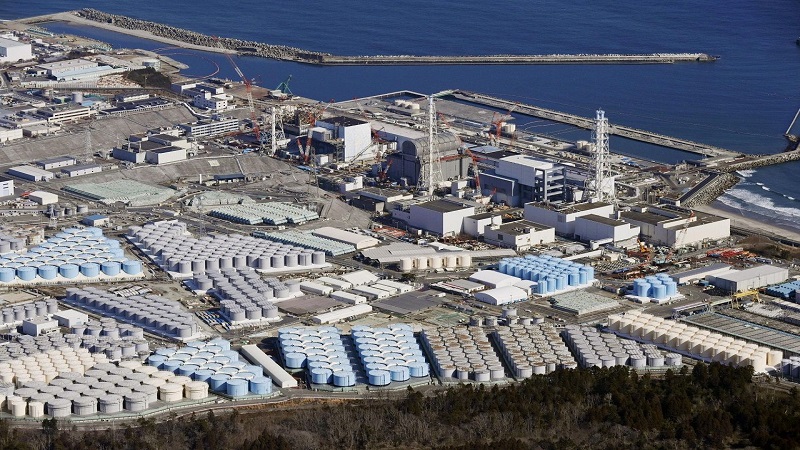Japan says it will release more than one million tonnes of contaminated water from the ruined Fukushima nuclear power station back into the sea, in a decision that drew swift condemnation from China, South Korea and environmental groups and is likely to anger the fishing industry.
The work to release the water will begin in about two years, the government said, and is expected to take decades.
Tokyo Electric Power, which operates the plant, will handle the process.
“On the premise of strict compliance with regulatory standards that have been established, we select oceanic release,” the government said in a statement after relevant ministers formalised the decision.
The water, equivalent to about 500 Olympic-sized swimming pools, has been treated but needs to be filtered again to remove harmful isotopes. It will also be diluted to meet international standards before any release into the ocean.
“Releasing the … treated water is an unavoidable task to decommission the Fukushima Dai-ichi Nuclear Power Plant and reconstruct the Fukushima area,” Prime Minister Yoshihide Suga said of the process.
In a statement, China’s foreign ministry called the move “extremely irresponsible” and said it reserved the right to take further action.
South Korea’s government said the plan was “totally unacceptable” and that it would lodge a formal complaint with Japan.
At a demonstration outside the Japanese embassy in Seoul, Al Jazeera’s Rob McBride said some protesters considered the move “nuclear terrorism”. Taiwan has also expressed concern about the plan.
The water currently contains significant amounts of harmful isotopes despite years of treatment, according to TEPCO. The company plans further filtration to leave only tritium, a radioactive isotope of hydrogen that is hard to separate from water.
A Scientific American article reported in 2014 that when ingested tritium can raise cancer risks, while some experts are worried about other contaminants.
“My concern is about non-tritium radioactive contaminants that still remain in the tanks at high levels,” Ken Buesseler, a senior scientist at the Woods Hole Oceanographic Institution in Massachusetts told Reuters news agency.
“These other contaminants are all of greater health risk than tritium and accumulate more readily in seafood and sea floor sediments,” added Buesseler, who has studied the waters around Fukushima.
Greenpeace Japan said it “strongly condemned” the decision.
“The Japanese government has once again failed the people of Fukushima,” Kazue Suzuki, a climate change and energy campaigner at Greenpeace Japan, said in a statement. “The government has taken the wholly unjustified decision to deliberately contaminate the Pacific Ocean with radioactive wastes. Rather than using the best available technology to minimize radiation hazards by storing and processing the water over the longer term, they have opted for the cheapest option.”
On Monday, the environmental group said it had gathered 183,754 signatures from Japan and South Korea in a petition against the plan.
Greenpeace International’s Executive Director Jennifer Morgan said the planned discharge would also be a violation of Japan’s obligations under the United Nations Convention on the Law of the Sea (UNCLOS) and that the move would be “strongly resisted” in the months ahead.
Not acceptable
The announcement of the plan, 10 years after the nuclear power station was devastated in a tsunami triggered by one of the most powerful earthquakes ever recorded, is also another blow to the fishing industry in Fukushima, which has opposed the release for years. Fishing unions have said releasing the water would have a “catastrophic impact” on the industry.
Five special rapporteurs from the United Nations said in March that the contaminated water remained a risk and that the ocean discharge plan could not be an “acceptable solution”.
The water, used to cool the reactors after the meltdown in March 2011, is currently stored in tanks in and around the plant, on Japan’s northeast coast.
US State Department spokesman Ned Price noted Japan had been managing the aftermath of the disaster in “close coordination” with the International Atomic Energy Agency.
“In this unique and challenging situation, Japan has weighed the options and effects, has been transparent about its decision and appears to have adopted an approach in accordance with globally accepted nuclear safety standards,” Price said in a statement.
Tens of thousands of people were evacuated after the 2011 disaster and the UN says about 40,000 people remain unable to return to their homes because of the radioactive contamination. Decommissioning the plant and cleaning up the radiation is expected to take decades.
The decision comes about three months ahead of the Tokyo Olympics, which were delayed by a year because of the COVID-19 pandemic. Some events are planned to take place as near as 60 kilometres (35 miles) to the ruined plant.
Source: Al Jazeera






 WhatsApp us
WhatsApp us 

